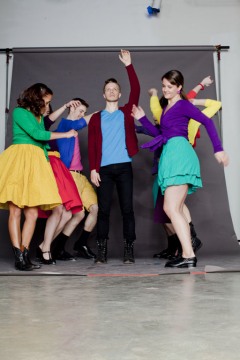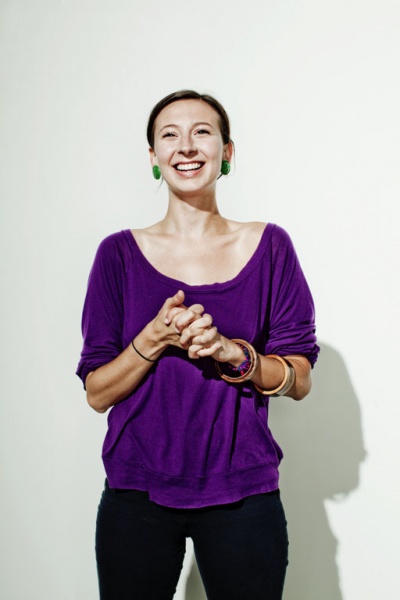MOMENTUM: Chris Yon and Kaleena Miller
Lightsey Darst took in the first weekend of this year's MOMENTUM series, presented by the Walker and the Southern Theater. The festival returns triumphantly after a one-year hiatus, with strong performances by choreographers Chris Yon and Kaleena Miller.




BACK AFTER A ONE-YEAR HIATUS, the Walker and the Southern Theater’s Momentum series again proved its importance with two excellent new works from rising choreographers Chris Yon and Kaleena Miller, both breaking ground for themselves and others. Now if only someone would create a similar mid-career commissioning program for these choreographers’ next works…
Chris Yon‘s Echo Park Dream Ballet Essay: Les Sylphides without Margot Fonteyn v. The Pips without Gladys Knight might be a little hard to take. True to its title, Echo Park is all back-up dancer and corps de ballet, no diva or prima, with a soundtrack to match — all fanfare and prelude with static pops, clicks, and the scratch of someone picking up the needle to hear that same swatch of nothing again. The guy behind me assessed it as “like being stuck in calculus class with a skipping record playing”. But if you can get past wanting something to happen, Echo Park offers its own pleasures.
One pleasure is simply the calculus of corps movement. If you’ve ever seen Les Sylphides (skipping over the Pips for reasons that will become apparent later), you know that the corps makes this ballet: the corps is the scenery, atmosphere, orchestra, all the second thoughts and afterthoughts and fleeting recurrences that haunt this ghostly ballet. Deployed in intricate symmetries and patterns, they are structure and ornament at once. Yon isolates and elevates this background action at the same time that he catches the feel of the ballet using mostly modern movement (pedestrian, that is, not ballet’s specialized vocabulary). The result is a tight mosaic in which your wandering eyes follow now one line, now another. It’s a rich little universe of puzzle piece involutions, diagonals that arise and fall apart, and brief precious stillnesses.
With the Pips (and this dance is pretty clearly divided by its soundtrack), Yon either has less to work with or he sees less deeply into it. Here, he at times fades into unabashed but unaccomplished jazz moves (a lot of step touch step kick) or (especially in his opening solo) ironic commentary on those moves. Ironic commentary is fun, and Yon does it well, but it’s predictably kitschy fun, not the transformative play he achieves with Les Sylphides.
So much for Les Sylphides v. the Pips — a clear victory for the sylphs, in my opinion. But what about Yon’s nostalgic main title, Echo Park Dream Ballet? (Echo Park is where Yon first took dance class as a child.) I sense a tribute here, a love for something that most people never notice. Let me explain. Freed of the pressure of stardom, drilled to selfless uniformity, the best corps dancers abandon themselves to their own anonymity and the demands of the choreography. No one looks at them, they’re not central, but what they give makes the stage world live, and yet they take no glory, only a half-sensual, half-devotional pleasure in their precision and expertise. Pouring life into every detail, Yon and his dancers radiate this selfless pleasure. It’s in Angharad Davies’ face as she traces an intricate sequence of arm semaphore; it’s in everyone’s intake of breath as they start an exhausting phrase of jumps; it’s in their sweat-shimmering faces; it’s in Taryn Griggs’s juicy finishes and her shining hair.
Last image: with the curtain coming down, the dancers still and dramatically lit from one side; suddenly they turn their heads expectantly. Here comes the star.
______________________________________________________
Miller turns her usual rangy Olive Oyl charm to hunch-shouldered, hunkered-down hurt as she winds along through a rhythmic labyrinth.
______________________________________________________
KALEENA MILLER‘S Fleet didn’t sound promising when I first heard about it: a tap/percussive dance dealing with her father’s advancing Alzheimer’s. And at first, Fleet is just what I was afraid of: one dancer clicks on a light and a brightly dressed crew clippety-clop out and greet each other with the bonhomie of teenagers in a musical, then tap gaily to recorded music (which, incidentally, almost always sounds off to me — the tap echoes and the music seem to arrive slightly out of sync). When the routine is over, the first dancer turns out the light, but then the dance starts over around him. He can’t remember his place, so the others nudge him through the routine. The third time, not even nudges can set him right, and the whole thing collapses. This is all done well, but it’s a one-level metaphor, with the dance as a mere pretext, not a mode of exploration or understanding in itself.
But Miller can do better. In fact, she does a lot better. Let me first get out of the way, though, her choreographic skill, which has improved miles since I last saw her work. Clearly, she used her time at the University of Minnesota dance program wisely, picking up a sense of stage drama and adding muscular modern moves to her toolkit. She’s also got a capable cast, including some standouts: whirlwind Ned Sturgis, loose but fierce Jessica Fiala, and new to me, Galen Higgins, a whirligig in red jeans.
Back to the point, though: Fleet really hits its stride when Miller starts to think about memory loss through percussion. The beat can menace, as when a line of dancers stomp their way forward, heads lowered and eyes intent; get in there and you’ve got to know what you’re doing. When Miller takes the stage for a solo (alongside drummer Patrick Nelson), she turns her usual rangy Olive Oyl charm to hunch-shouldered, hunkered-down hurt as she winds along through a rhythmic labyrinth. Stripped of the tapper’s usual conspiratorial smile, her improvisational achievement feels desperate: can she make it come out right, can she get through the maze she’s set up? Each beat is vital, all the way down to nervous, tiny, nearly inaudible hammerings like neurons firing. And the metaphor slips further: you realize that without the fanfare to signify, you don’t know whether Miller’s done what she wanted to, whether she really has come out right. Tap’s improvisational freedom starts to feel like freefall. If you have to keep inventing, there’s no way out of that solo. Sooner or later, you’ll miss the beat — but by then, will you even know?
Later, Miller brings back her colorful cohort for a follow-the-leader freestyle, a dance in which individual quirk and failure can nestle and jostle with the group’s beat. We have to believe it’s like that, that at some level we are together, whatever happens to us; to end the performance in her solo would be heartbreaking. But, even with this happier note, Miller doesn’t lie to us, doesn’t undo what came before. At the end of the dance, she alone steps forward and clicks out the light.
One last note: both these pieces could have used a little more support in the program. Momentum is a platform for emerging choreographers; perhaps emerging audiences can be part of the plan too. Not everyone read the excellent interviews in the Walker magazine ahead of time (or listened to Justin Jones’s podcast), and you don’t need to in order to enjoy the show, but a few pointers might have helped (i.e. for Yon, think pattern, trance, meditation — and don’t look for a story). Miller’s audience didn’t all know about her father’s Alzheimer’s; some just wondered why she wasn’t smiling — and that’s a shame. The girl I saw crying after the show had an experience I wish everyone in the audience could have shared with her.
______________________________________________________
Noted performance details:
The Momentum dance series, celebrating emerging choreographers, is presented by the Walker Art Center and the Southern Theater. The festival stages two weekends of dance performances, from July 14-23, at the Southern in Minneapolis.
______________________________________________________
About the author: Originally from Tallahassee, Lightsey Darst is a poet, dance writer, and adjunct instructor at various Twin Cities colleges. Her manuscript Find the Girl was recently published by Coffee House; she has also been awarded a 2007 NEA Fellowship. She hosts the writing salon, “The Works.”